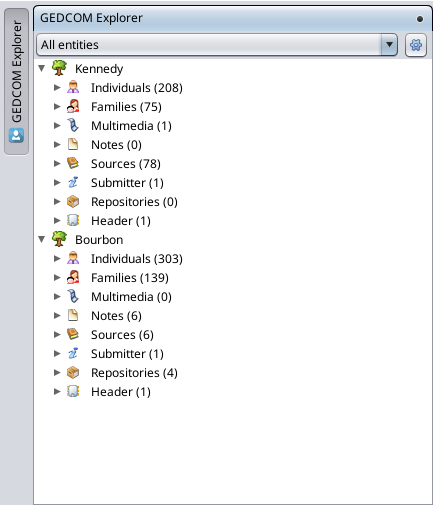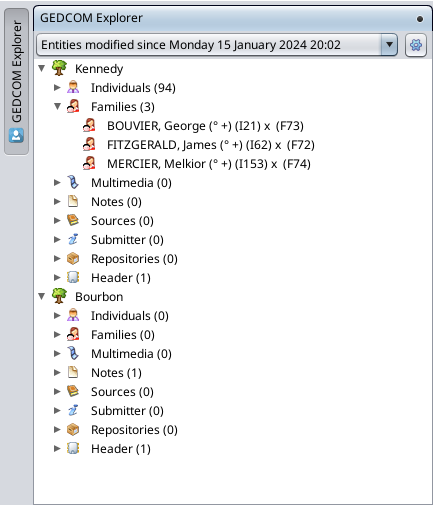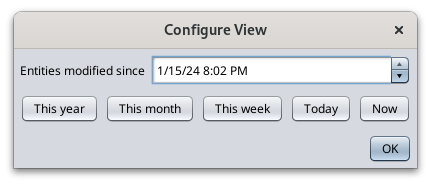GEDCOM Explorer
The GEDCOM Explorer is a special Ancestris window dedicated to the exploration of each open genealogy Gedcom file.
Several Gedcom files can be open at the same time.
A modification time filter can be applied to limit the exploration.
Description
Window
This window appears in the upper left corner of Ancestris, in the form of a concealed window with a vertical button.
It is always present and always available, even if it can be temporarily hidden.
The GEDCOM Explorer displays a summary of the different entities included in the Gedcom files currently open in Ancestris. If no genealogy file is open, it only displays a blank page.
Each file opened in Ancestris is presented as a three-level tree structure.
- First level: the name of the genealogy file
- Second level: the name of one of the seven categories of entities, and the header, followed in brackets by the number of entities.
- Third level: the name of the entities
The tree structure is similar to that found in most file managers.
- For better reading, the different lines are indented according to their level in the hierarchy
- To limit the use of the vertical scrollbar, a flap allows you to show or hide the content of the lower level by clicking on it.
In the example above, we see the GEDCOM Explorer with two open Genealogies, those of Kennedy and the Bourbons. We see for example that there are 208 individuals in the Kennedy genealogy, and 303 in the Bourbon genealogy.
Menu bar
Filter selector
The filter selector offers the choice to either see All entities, or only the entities modified since a certain date.
In the image below, only the entities modified since Monday 15 January 2024 20:02 are listed.
For instance, compared to the "All entities" view above in this page, only 94 individuals out of 208 appear, and only 3 families out of 75.
Configure View button
From this window, you can easily set a date and time you need to filter the list of entities.
Usage
The GEDCOM Explorer has multiple purposes.
- It helps you count all the entities included in the genealogy files currently open in Ancestris.
- It helps you select any entity in the genealogy by double-clicking on it.
- It helps you count and select the most recently modified entities using the filter described above.
It also provides a number of rather practical possibilities with the context menu.
Double-click
A double-click on a line with a flap unfolds or folds the lines underneath.
A double-click on an entity selects the entity and makes it the selected entity.
You can display the context menu by clicking on a line of the tree structure.
A right click on a Gedcom level opens a specific Gedcom context menu where you can perform a number of actions that are specifically relevant to the Gedcom file selected.
A right-click on a category of entity does nothing.
A right-click on an entity level opens the Context Menu. From there, you can achieve many actions like creating other entities, editing them, using tools and reports, etc.
Possible configurations of the window
Concealed
The concealed position is the default position of the GEDCOM Explorer when Ancestris is opened.
In this form, the tab remains at the top of the left edge of the main window and the panel is usually hidden.
To show the GEDCOM Explorer pane.
- either, hover (for a few fractions of a second) over its tab with the mouse
- or, more radically, click on this button
- or access it from the main menu / Window / GEDCOM Explorer
To hide the GEDCOM Explorer pane again.
- either, hover with the mouse (for a few fractions of a second) over any part of the screen outside this frame
- or, more radically, click again on the button
When the panel is displayed, GEDCOM Explorer can take the form of an anchored panel by clicking on the anchor pin, located at the top right of the open pane.
Anchored
The panel anchored to the main window is a non-overlapping pane: GEDCOM Explorer is therefore always visible, as long as the main window remains in the foreground.
From this anchored frame pane, GEDCOM Explorer can take the following forms.
- A open panel in a secondary window, using the Undock command of the pop-up menu managing the panel and window control, opened by right-clicking on the panel tab.
- A concealed panel
- either by using the Reduce window group button located at the top right of this anchored frame. It returns to the initial state in the form of an open concealed panel
- or by means of the menu command main menu / Window / GEDCOM Explorer. It returns to the initial state in the form of an open concealed panel
Panel in secondary window
The Gedcom explorer can be put in a floating window, or freed, via the actions of the window menu.
In this case, the Gedcom Explorer is autonomous from the main window from which it has been detached.
From this freed window, the Gedcom Explorer can take the following forms.
- A docked panel, using the Dock command in the context menu
- A concealed panel, via the main menu / Window / GEDCOM Explorer . It returns to the initial state in the form of an open concealed panel
Personalisation
The settings of this window can be accessed via the Configure View button of the Menu bar.





